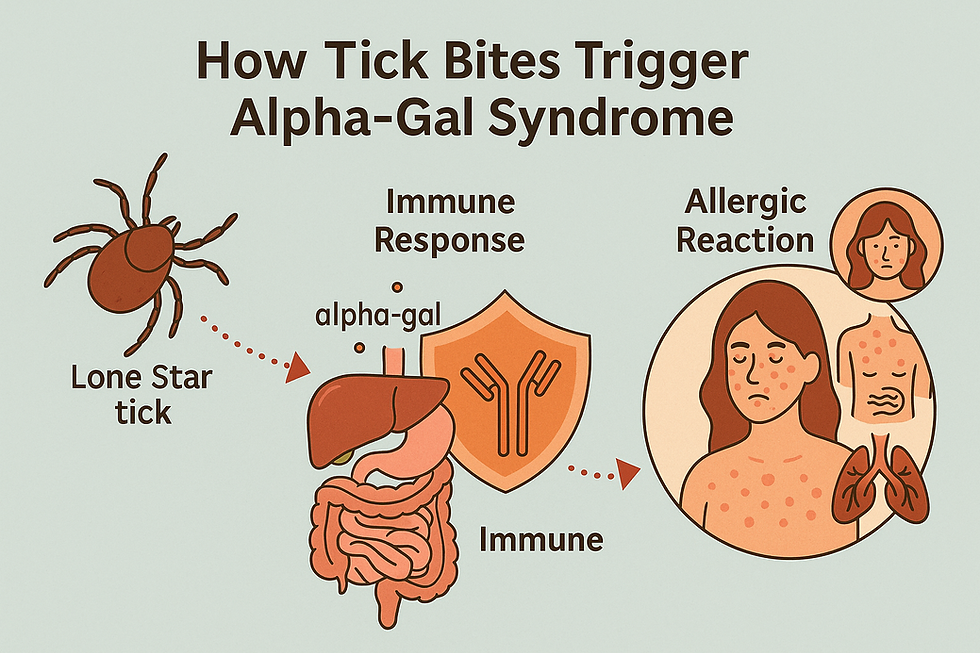🧬 What Is Alpha-Gal Syndrome? Symptoms, Causes, and Research
- Jordan Concannon
- Apr 28
- 3 min read
Alpha-Gal Syndrome (AGS) is an emerging, tick-borne food allergy that causes delayed allergic reactions to red meat and other mammalian products. Unlike typical food allergies, AGS is triggered by a sugar molecule, not a protein, and symptoms often appear hours after consumption. Understanding AGS is crucial for those affected and for raising awareness about this condition.
🧠 What Is Alpha-Gal Syndrome?
AGS is an IgE-mediated allergic reaction to galactose-α-1,3-galactose (alpha-gal), a carbohydrate found in most mammals but not in humans, apes, or Old World monkeys. When a person develops AGS, their immune system reacts to this sugar molecule, leading to allergic symptoms upon consuming mammalian meat or products.

🦟 How Do Tick Bites Cause AGS?
The primary cause of AGS in the United States is the bite of the Lone Star tick (Amblyomma americanum).
Here's how it happens:
Tick Bite: The Lone Star tick bites a human, introducing alpha-gal into the bloodstream.
Immune Response: The body recognizes alpha-gal as foreign and produces IgE antibodies against it.
Allergic Reaction: Upon consuming red meat or mammalian products, the immune system triggers an allergic response due to the presence of alpha-gal.
This mechanism explains the delayed onset of symptoms, as the body reacts to the alpha-gal in the consumed food hours after ingestion.
🩺 Symptoms of Alpha-Gal Syndrome
Symptoms typically appear 2 to 6 hours after consuming red meat or mammalian products and can range from mild to severe:
Skin Reactions: Hives, itching, or scaly skin.
Gastrointestinal Issues: Stomach pain, diarrhea, nausea, or vomiting.
Respiratory Symptoms: Shortness of breath, wheezing.
Anaphylaxis: Severe allergic reaction that can be life-threatening.
It's important to note that the delayed nature of these symptoms can make AGS difficult to diagnose.
🧪 Diagnosis and Testing
Diagnosing AGS involves:
Patient History: Noting delayed allergic reactions after consuming red meat.
Blood Tests: Measuring IgE antibodies specific to alpha-gal.
Skin Tests: Less reliable but may be used in conjunction with other tests.
Consulting with an allergist familiar with AGS is recommended for accurate diagnosis.
🌐 Prevalence and Research
AGS is increasingly recognized in the southeastern, south-central, and mid-Atlantic United States, correlating with the habitat of the Lone Star tick. However, cases have been reported in other regions, suggesting a broader distribution.
Recent studies have highlighted:
Rising Cases: Over 34,000 reported cases by 2019, up from just 24 in 2009.
Underdiagnosis: Many cases may go unreported due to lack of awareness among healthcare providers.
Research Efforts: Ongoing studies aim to understand the mechanisms of AGS and develop potential treatments.
🛡️ Prevention and Management
Currently, the scientific community says there's no cure for AGS, but management includes:
Avoiding Tick Bites: Use insect repellents, wear protective clothing, and perform tick checks after outdoor activities.
Dietary Changes: Eliminate red meat and mammalian products from the diet.
Emergency Preparedness: Carry an epinephrine auto-injector if prescribed.
Awareness and preventive measures are key to managing AGS effectively.
Stay healthy friends,
Jordan



Comments